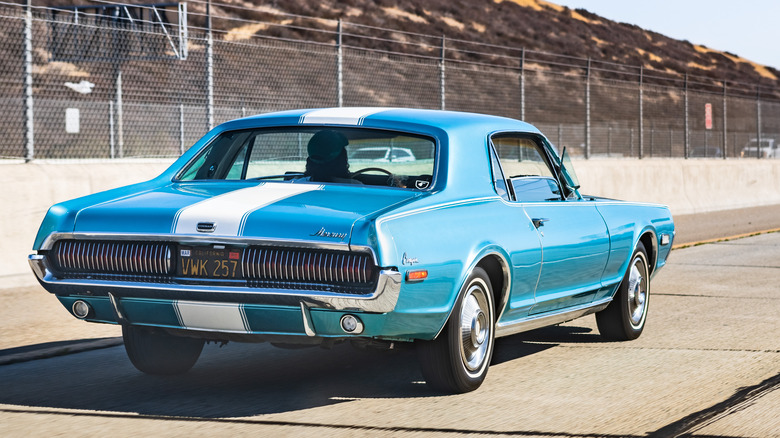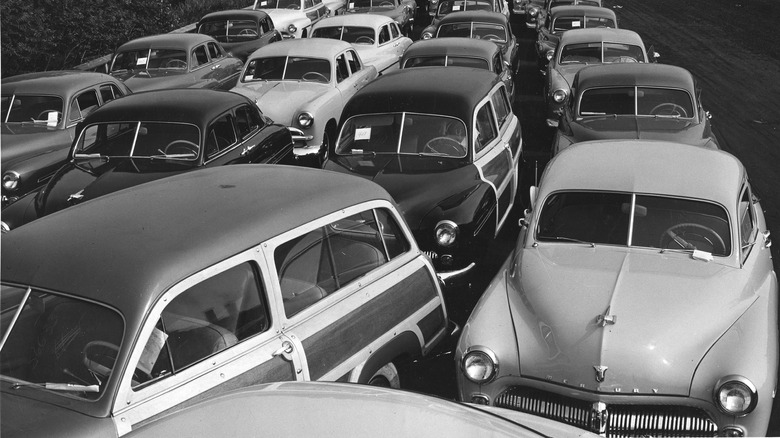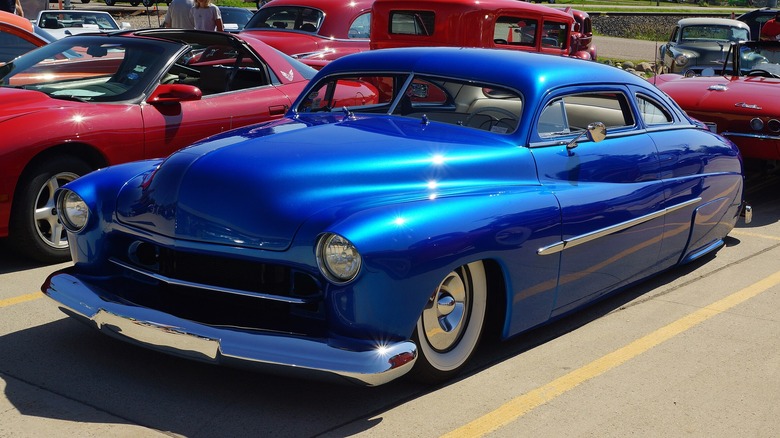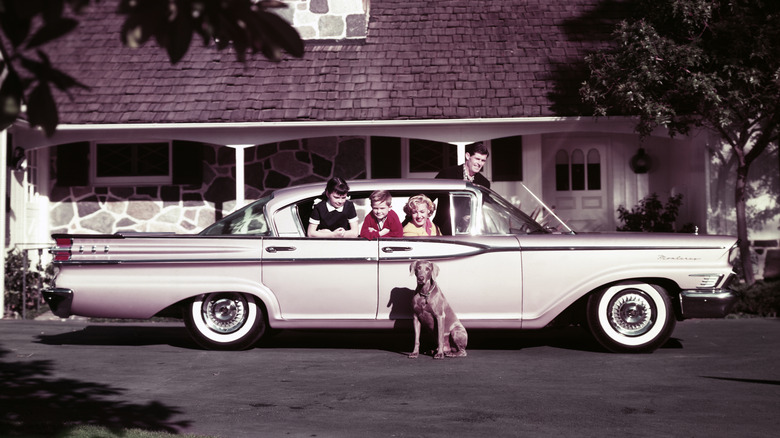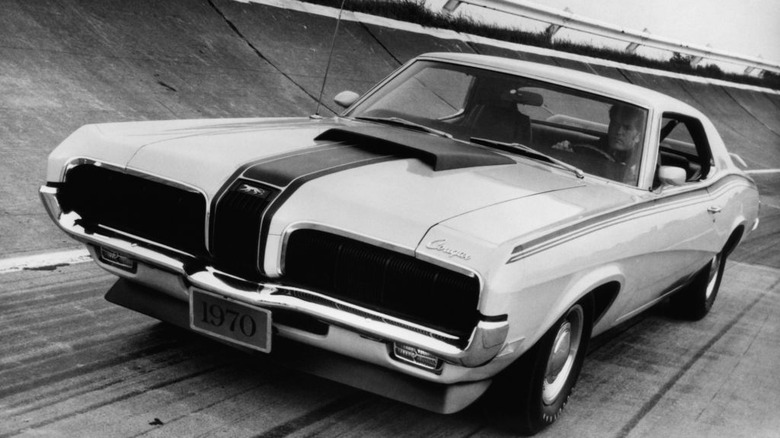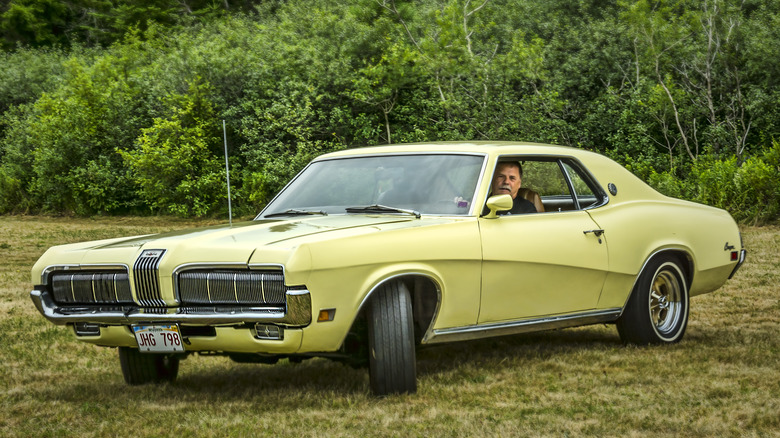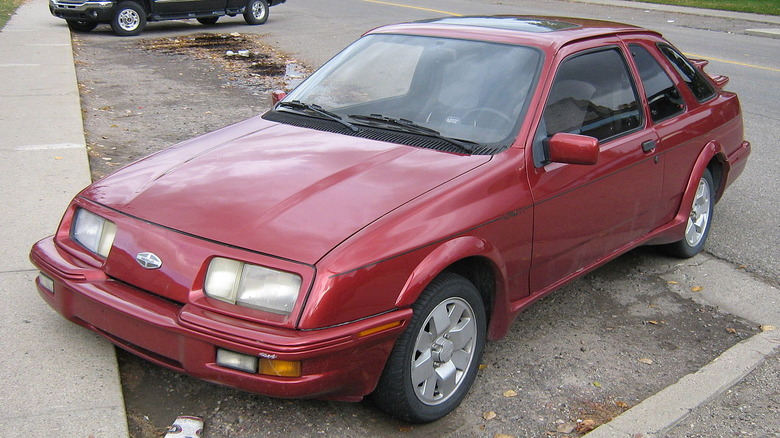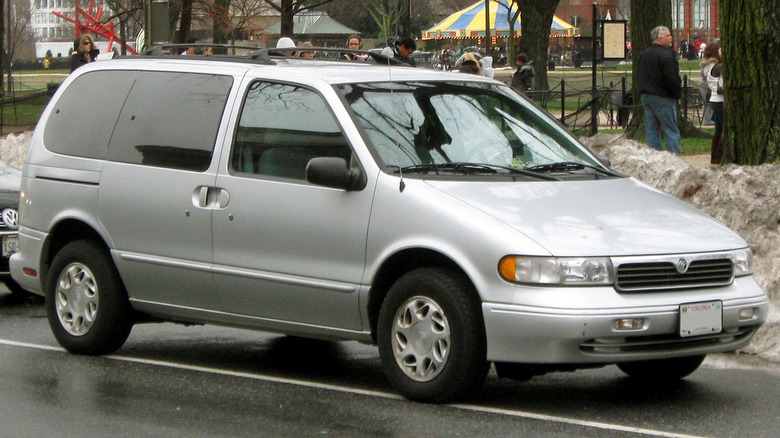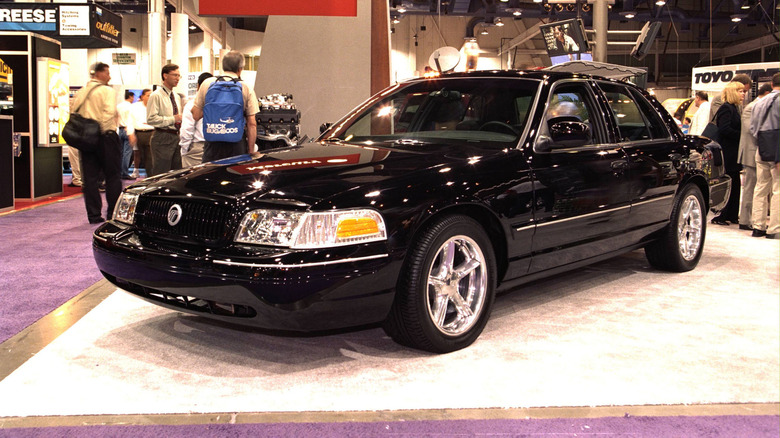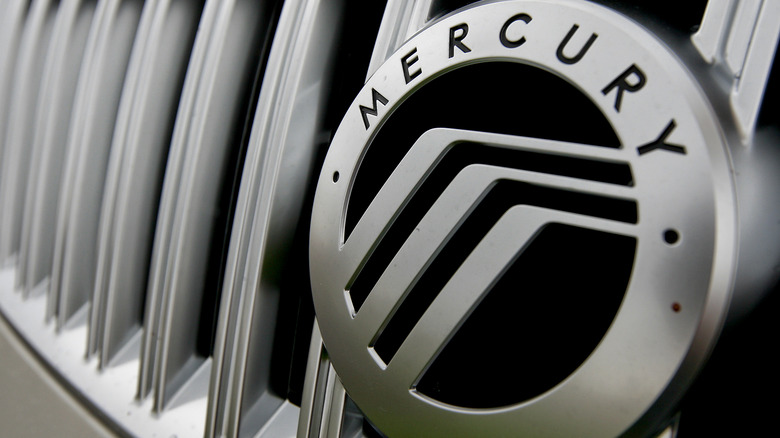The Rise And Fall: Why Ford Ended The Mercury Brand After 70+ Years
American automotive history is filled with once-great marques that, after years of neglect and slow sales, eventually faced the chop and became defunct car brands. Oldsmobile, Pontiac, Saturn, and Plymouth make up just a few of those marques, alongside Mercury, Ford Motor Company's middle-child brand that slotted in between its Ford and Lincoln models. In its heyday, Mercury offered a range of exciting, competitive cars and drew consistently strong sales figures, but by the time it was axed, the brand was already a shadow of its former self.
The question of whether the Mercury brand could have been saved is not a straightforward one to answer. Its fall was gradual, with consistently slipping sales combined with a stagnating lineup spelling the end for the brand long before it was officially killed off. When the announcement finally came that it was being axed, few were surprised, and buyers who mourned its loss the most were mainly those who remembered (or still owned) vehicles from Mercury's glory days.
To see exactly where the brand went wrong, it's worth looking back at Mercury's history, both in its rise to prominence and eventual fall from grace.
Mercury is introduced
In the mid-'30s, Ford bosses realized the company was missing out on a lucrative slice of the domestic car market. Its Ford-branded cars catered to buyers looking for everyday vehicles while its Lincoln brand competed in the luxury segment, but it was missing a mid-tier range to cover the middle of the spectrum. Mercury was conceived specifically to fill this gap. Development of its first vehicle, the Mercury Eight, was finished in 1938, and went on sale for the 1939 model year.
It packed a V8 engine making 95 horsepower, and was available in various body styles. A convertible was offered, alongside three variants of the sedan. It proved successful at launch, with Ford selling around 65,000 examples of the new Mercury in its first year. However, that success would be short-lived, as when the U.S. joined the Second World War in 1941, Ford was forced to stop all civilian car production to help the military effort.
Launch of the lead sled
After the war ended, car production resumed, although it would take until 1949 for the next significant model in Mercury's history to be developed. That was the '49 Mercury Eight, which featured an all-new design that quickly became a hit with hot rodders. Nicknamed the "lead sled," it gained widespread popularity thanks to its appearance in James Dean's "Rebel Without A Cause," and solidified Mercury as a serious force in the American car industry.
The most famous example of a lead sled is Bob Hirohata's '51 Mercury Eight, which was customized by Barris Kustom Cars. It became a hit when it was displayed at the 1952 Motorama. After spending several years fronting magazine covers and even featuring in a movie, it was eventually sold on by Hirohata, and spent decades in obscurity before a high-profile restoration in the '90s saw it thrust back into the spotlight. Today, the lead sled remains one of the most instantly recognizable hot rod styles, and indeed one of the most iconic Mercury vehicles ever made.
[Featured image by Greg Gjerdingen via Wikimedia Commons | Cropped and scaled | CC BY 2.0]
Increased competition and success
Throughout the mid-'50s, the Mercury brand continued to see success, with models like the Montclair and Monterey cementing its place as a strong performer in the sales charts and drawing hordes of new customers into dealerships. The 1954 model year saw the launch of the brand's first overhead valve V8, while 1957 saw a new chassis debut to separate Mercurys from Ford and Lincoln models.
It wasn't all good news — sales dropped dramatically in 1958, and didn't fare much better the following year. Late '50s models had grown in both size and weight, and suddenly were less affordable and less fashionable for cash-strapped buyers. They were also loaded with cutting-edge tech, which many buyers either didn't care for, or couldn't justify shelling out for. With Ford's disastrous launch of another brand, Edsel, causing huge losses and plenty of embarrassment for company bosses, rethinking the Mercury lineup was needed if the automaker was to return to profitability.
The performance car years
As the new decade rolled around, Mercury began to overhaul its lineup, reducing prices and unveiling a new range of more compact cars based on Ford platforms, as opposed to being uniquely designed as previous model years had been. The mid-'60s also saw the brand's first muscle cars launched, while popular models like the Comet reinforced sales numbers at the more affordable end of Mercury's lineup.
Many of the most prized Mercury classics today hail from the era, although not all of today's most desirable models sold particularly well at the time. The 1967 model year also saw the launch of one of the brand's most important models, the Mercury Cougar. It was positioned as a more upscale alternative to the Ford Mustang, and won both critical and commercial acclaim, becoming MotorTrend's Car of the Year upon its release. It delivered both performance and luxury, and helped shape the direction of Mercury cars to come over the following years.
Changing times
As the floor fell out on the muscle car market in the early '70s, Mercury's lineup lost one of its key elements of appeal. Suddenly, the idea of a sporty, luxurious car was no longer a marketable one, and so Mercury focused on the luxury aspect in an attempt to differentiate itself from Ford. Although many of its mid-'70s cars don't command as much respect from modern collectors, they sold very well at the time — the Grand Marquis was launched in 1975, and would go on to become the brand's best-selling model. The 1978 model year saw Mercury record its largest-ever sales volume, at 580,000 units.
Alongside its larger models, the brand also saw success with the second-generation Capri, which launched in 1979 and, much like the original Cougar, was positioned as a more luxurious alternative to the Mustang. It shared the Foxbody platform, but featured European-inspired styling, replacing the previous generation Capri, a Euro import built in Ford's factory in Germany.
Modernisation and Merkur
Throughout the '80s, Mercury continued to update its lineup, launching smaller models to cater to the market's changing tastes. This proved to be a generally successful strategy, with models like the Cougar and Grand Marquis keeping sales figures high and buyers returning to the brand. However, there's one particular flop that stands out among the triumphs: the Merkur sub-brand. While not technically marketed as a Mercury, Merkur cars were sold in Lincoln-Mercury dealerships, and the name Merkur is derived from the German word for "Mercury."
They were, however, completely different from anything else in said dealerships at the time, more akin to a BMW 3 Series than a luxury cruiser. The Merkur XR4Ti was a reskinned Euro-spec Ford Sierra XR4Ti, albeit with a turbocharged four-cylinder instead of the European version's V6. While the Euro Sierra was a success and remains a cult collectors' car on the continent today, the XR4Ti never caught on in America, and neither did the larger Scorpio that was also briefly sold under the Merkur name. After launching in 1985, Merkur's consistently slow sales saw it killed off by 1990, and with it, bosses' appetites for taking risks with the Lincoln-Mercury division also waned.
[Featured image by Dave_7 via Wikimedia Commons | Cropped and scaled | CC BY-SA 2.0]
Minivans and SUVs
While Mercury in the '90s wouldn't do anything as radical as introducing a Euro-built sports sedan into its showrooms, it did branch out into more diverse segments. Two key models introduced during the decade were the Villager minivan and Mountaineer SUV. The Villager was a joint project between Nissan and Ford, and was a higher-spec alternative to the Ford Aerostar, and later, the Windstar. While it initially proved popular, the decline of the minivan segment saw sales figures shrink correspondingly. In its last model year before being axed, Mercury sold less than 17,000 examples.
The Mountaineer's appeal proved to be a little more long-lasting. Introduced in 1997 and based on the Ford Explorer, it soldiered on until the brand's demise in 2010, albeit with consistently falling sales from the mid-'00s onwards. These two new cars were sold alongside the brand's existing range of sedans, but the sales outlook wasn't much better for the core range either. The traditional three-box design was itself losing market share, and Mercury's sedans struggled to stand out in what was becoming an increasingly competitive segment.
[Featured image by IFCAR via Wikimedia Commons | Cropped and scaled | Public Domain]
Lost appeal
By the turn of the century, it was becoming clear that Mercury was a brand in decline. The 2003 Marauder gave fans a last glimmer of hope with its 305 horsepower V8 and sleeper sedan credentials, but it wasn't enough to turn the ship around. During its last years, the Mercury lineup had gradually lost any unique identity it had left, and had simply become a range of slightly dressed-up Fords that offered little to tempt buyers away from rival showrooms.
Arguably, Ford's lack of effort with Mercury could have been a result of its crowded stable of brands. By the year 2000, Ford owned Volvo, Jaguar, Land Rover, Aston Martin, and part of Mazda in addition to its Mercury and Lincoln brands. Its finances were beginning to crumble and there simply wasn't enough development cash around to keep each brand churning out unique products, and so some were inevitably neglected. The Great Recession compounded Ford's financial problems and forced it to start selling its acquired brands, but by then, it was too late for Mercury.
An unceremonious end
In June 2010, Ford announced it was axing its Mercury brand at the end of the year, with no direct replacement. Instead, its luxury Lincoln arm was to be revitalized, expanding its lineup with all-new models, while Ford-branded cars would fill in the gap left by Mercury's entry-level offerings. The last Mercury ever to be produced was a Grand Marquis, and left the factory line in January 2011. Ford bosses noted at the time that most of Mercury's remaining customers were either fleet buyers or those using employee discounts, leaving the brand with very little in the way of individual customers to lose.
Whether Mercury could have made a comeback with enough investment is debatable; while the '00s were not the first time the brand had been faced with declining sales and an outdated lineup, previous rough patches had the advantage of being able to draw on the brand's residual prestige from its glory days. By 2010, those glory days were too far gone, and Mercury had failed to win over enough customers in the newly popular SUV segment to bring in customers from outside the brand's existing clientele.
Even if Mercury had been given a boost of development cash, it might still not have been enough to save Ford's middle brand from ending up consigned to the archives with the other great American marques.
